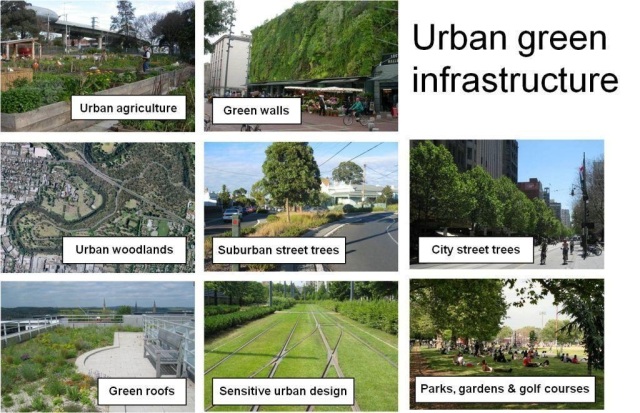However, it is not all dark and gloomy. Recent technological advancements coupled with intensive Research and Development (R& D) have bore fruit. With increasing emphasis on building green cities, numerous creative and innovative ideas have been mooted and most are already in place. Examples can be seen in the picture below, and by the way, I think urban agriculture is a really cool practice!
 |
| GREEN INFRASTRUCTURE. PHOTO: THEGIRG.ORG |
Do give these 3 journal papers a read ( 1, 2 and 3) The 1st paper talks about how urbanisation may paradoxically, drive biodiversity. The 2nd paper studies ways that urbanisation can foster an ecologically heterogeneous city, while the 3rd paper highlights the importance of sustaining urban biodiversity.
While I generally with the 2nd and 3rd journal paper, the 1st paper invoked in me a rather strong sense of emotion. The paper means no harm in highlighting an interesting insight into how wastelands provide space for wildlife to thrive, but what about land-scarce countries like Singapore? Also, it seems like we are segregating animals and humans from each other, and for me at least, I'd very much prefer coexistence and cohabitation with animals, although practicality and realism tells me that this may not work out as well as I'd have hoped for. Other than that, the paper gave me hope, that biodiversity and cities need not be mutually exclusive, and this belief has been reinforced when I read an article about otters who have made their home in (of all places), the Central Business District Area (CBD) of Singapore.
It was a surprise when 2 otters were first spotted in February 2014 within Marina Reservoir and around the coasts of Gardens By The Bay, but an even bigger surprise is that these otters have now raised 5 pups (Ee, 2014). Despite the enclosed area far from freshwater sources, these otters seem to have adapted fairly well, and may have gradually adapted to our urban environment. (Impressive!)
 |
| OTTERS IN THE MARINA RESERVOIR. PHOTO: JEFFERY TEO |
Meanwhile, knowing these otters have made the Marina Area their home have placed a smile on my face. Not so much that we may get to see them up close once in a while, but because once again, these animals have shown that they will not back down. They will fight for their survival and try their best to adapt. It is time for humans to join in the fight and make a genuine effort to protect their habitats and spaces. Also, do not simply write off the notion that anything urban, cannot be wild.
And by the way, Singapore aim to be a "City in a Garden". Yet, our ecological footprint is the highest in Asia, and our green ranking has (rather dishearteningly) worsened, ranking as having the 7th largest ecological footprint in the world. Looks like our aim is still a work in progress.
Literature Citied
Conniff, R. 2014. Urban Nature: How to Foster Biodiversity in World’s Cities. [ONLINE] Available at: http://e360.yale.edu/feature/urban_nature_how_to_foster_biodiversity_in_worlds_cities/2725/. [Accessed 10 October 14].
Ee, D. (2014). Wild otters raise family around Marina Bay. [ONLINE] Available at: http://www.straitstimes.com/news/singapore/more-singapore-stories/story/wild-otters-raise-family-around-marina-bay-20140928. [Accessed 10 October 14].
No comments:
Post a Comment